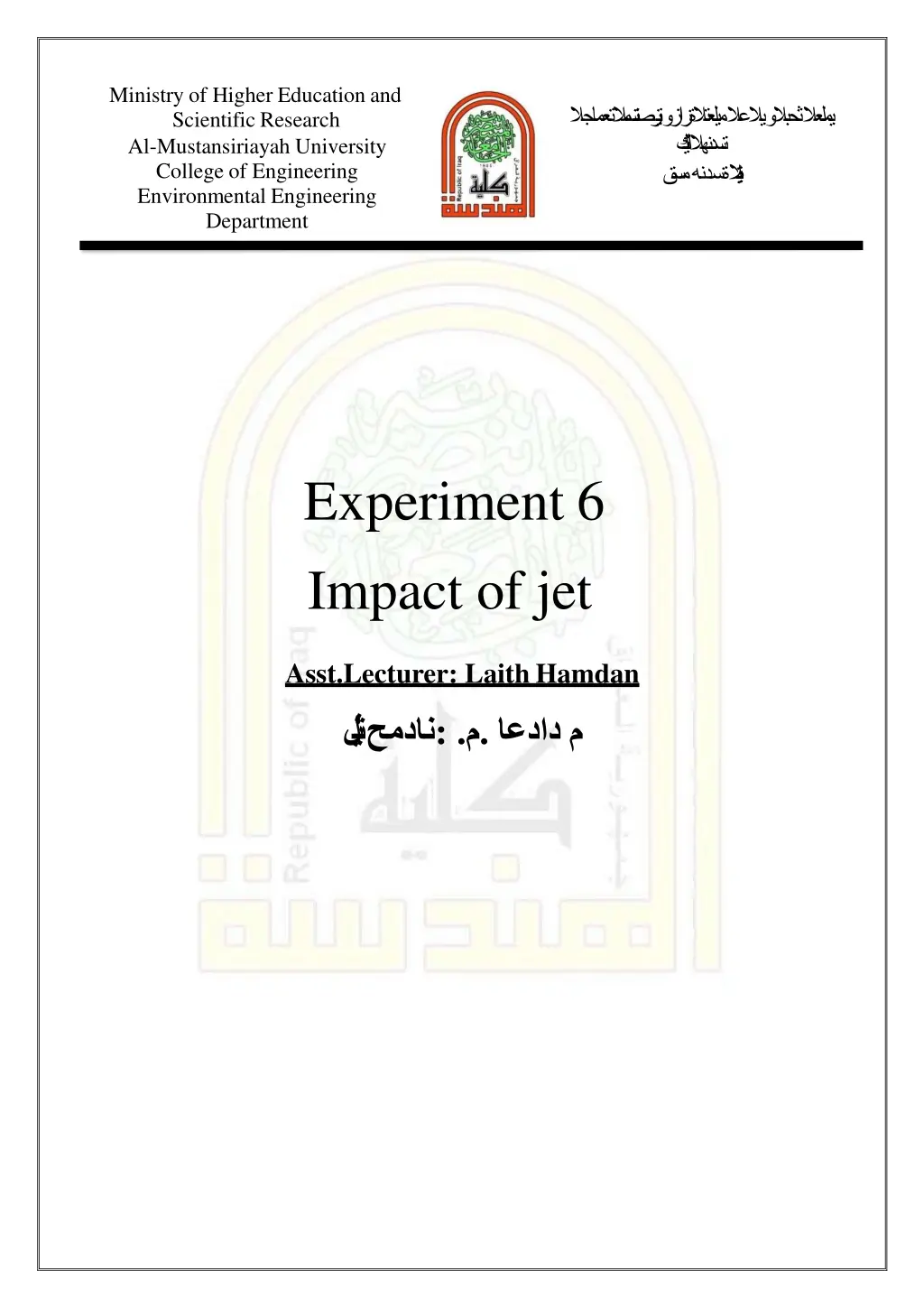
Impact of Jet Experiment at Al-Mustansiriayah University College of Engineering
Explore the Impact of Jet experiment conducted by the Environmental Engineering Department at Al-Mustansiriayah University College of Engineering. The experiment measures the force generated by a jet of water striking a flat plate or hemispherical cup, comparing it with the flow rate in the jet.
Download Presentation

Please find below an Image/Link to download the presentation.
The content on the website is provided AS IS for your information and personal use only. It may not be sold, licensed, or shared on other websites without obtaining consent from the author. If you encounter any issues during the download, it is possible that the publisher has removed the file from their server.
You are allowed to download the files provided on this website for personal or commercial use, subject to the condition that they are used lawfully. All files are the property of their respective owners.
The content on the website is provided AS IS for your information and personal use only. It may not be sold, licensed, or shared on other websites without obtaining consent from the author.
E N D
Presentation Transcript
Ministry of Higher Education and Scientific Research Al-Mustansiriayah University College of Engineering Environmental Engineering Department Experiment 6 Impact of jet Asst.Lecturer: LaithHamdan : . .
Objective: In this experiment, the force generated by a jet of water as it strikes a flat plate or hemispherical cup may be measured and compared with moment flow rate in the jet. Equipments and apparatus: The unit essentially consists of: Base Plate. Inlet connection. Drain connection. Perspex vessel. Nozzle. Deflector. Lever mechanism. Loading weights. Various deflectors can be fitted at position . Plate. Hemisphere. _ Cone Asst.Lecturer: LaithHamdan 1
Procedures: 1 Place the test set-up on the device so that the drain routes the water into the channel. 2 Fit connecting hose between device and unit. 3 Open device drain. 4 Assemble deflector, (Plate, Hemisphere or Cone). Loosen the 3 screws on the cover and remove cover together with lever mechanism. Fit appropriate deflector. Do not forget to tighten lock nut on rod. Screw cover back onto vessel. 5 Use adjusting screw to set pointer to zero (zero notch [7]). When doing so, do not place any loading weights on measurement system. 6 Apply desired loading weight 0.2N; 0.3N; 1N; 2N; 5N or combinations thereof. 7 Close main device cock. 8 Switch on device pump. 9Carefully open main cock until pointer is on zero again. 10- Close device drain cock. 11Determine volumetric flow. This involves recording time t required to fill up the volumetric tank of the device from 20 to 30 litres. 12 Add loading weights and note down time t for 10 litres. 13 Switch off pump, open drain. Theoretical background and Calculation: The momentum equation based on Newton s 2nd law of motion states that the algebraic sum of external forces applied to control volume of fluid in any direction equal to the rate of change of momentum in that direction. The external forces include the component of the weight of the fluid and of the forces exerted externally upon the boundary surface of control volume. If a vertical water jet moving with velocity V made to strike a target (Vane) which is free, to move in vertical direction, force will be exerted on the target by the impact of jet. Applying momentum equation in X- direction, force exerted by the jet on the vane is given by: Fj = Q (Vx2 cos ? -Vx1) Asst.Lecturer: LaithHamdan 2
The force F on the vane is equal and opposite to this, namely Fj = Q (Vx1- Vx2cos?) For flat plate, ?= 90, cos 90= 0, Fj = Q (V 1 V 2(0)), Fj = Q V1 = QV For hemispherical curved plate, = 180, cos 180= -1, Fj = Q [V1 - (-1) V2)] , where V1 = V 2 (If we neglect the effect of change of elevation on jet speed, and the loss of speed due to friction over the surface of the vane, then V1 = V 2) ,so Fj = 2 QV is the maximum possible value of force on the hemispherical cup. This is just twice the force on the flat plate. The mass flow rate m in the jet is found by timing the collection of a known mass of water. The velocity V1 of the jet as it leaves the nozzle is found from the volumetric flow rate Q and the cross sectional area A of the nozzle. The velocity V 2 with which the jet strikes the vane is slightly less than V1 because of the deceleration due to gravity. This effect may be calculated from the expression: V2 = V1-2gs Inserting the value s = 0.035 m leads to the result V2 = F mass = mass * g ( 9.81 m/ sec2) Where Q= Discharge from the nozzle (Calculated by volumetric method) V= Velocity of jet = (Q/A) Asst.Lecturer: LaithHamdan 3
Item Value Nozzle diameter: 8mm Distance between nozzle & target plate: 35mm Diameter of target plate: 36mm - 180 hemisphericaltarget - 120 target (cone) - flattarget - 30 target Target plates: 2015 2016 Asst.Lecturer: LaithHamdan 4






















